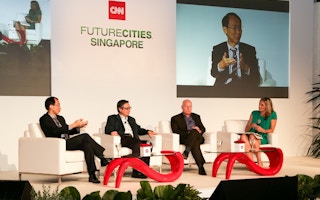Singapore is on the cusp of major infrastructure investments over the next two decades, presenting opportunities to improve its urban landscape and increase regional trade, said experts at a recent panel discussion on future cities in Singapore.
To continue reading, subscribe to Eco‑Business.
There's something for everyone. We offer a range of subscription plans.
- Access our stories and receive our Insights Weekly newsletter with the free EB Member plan.
- Unlock unlimited access to our content and archive with EB Circle.
- Publish your content with EB Premium.
An island-wide network of 1,000 sensors, a satellite-based congestion pricing system and a high-speed rail link with Malaysia are some ways Singapore is pursuing technology to give its citizens a better life, said Goh Chee Kiong, executive director of the Singapore Economic Development Board (EDB)’s clean technology and cities, infrastructure & industrial solutions practice.
“Singapore has always taken a very long-term view on how we carry out urban planning and invest in the right infrastructure,” Goh told an audience of about 100 public and private sector representatives at the Red Dot Design Museum on 24 June.
The panel discussion was organised by Japanese electronics firm Hitachi and US media firm CNN.
Explaining the ‘living lab’ concept, Goh said companies can use Singapore as a testbed to pilot and commercialise innovative urban solutions in close collaboration with government agencies.
Some solutions that have succeeded in Singapore - such as water treatment technology, transport management software, and transport management tools - could also be exported to the region, noted Goh. It is in these highly scaleable solutions that Singapore agencies are the most interested, he added.
One successful initiative was the development of a ‘Research Collaboratory‘ by information technology firm IBM, which together with the Land Transport Authority developed a traffic analytics solution with the Land Transport Authority. IBM later sold it internationally, said Goh.
However, Singapore must not lose sight of the fact that it is also home to citizens whose needs must be met, advised fellow panellist Stephen Cairns, scientific director of the urban research institute Future Cities Laboratory.
“I work in a laboratory, but would not want to live in one,” said the professor. While a living laboratory allows much freedom and flexibility to test new solutions, there are many risky technologies “that I do not want to see escape out of a laboratory or piloted widely,” he added.
To avoid such pitfalls, the Singapore government takes a systematic approach to how it engages with companies and technologies, said Goh.
Initiatives are first tested at a small scale by individual agencies before scaling up. For example, Singapore’s national water agency, PUB, has run about 150 pilots to try out various water treatment technologies to date, he said.
Promising initiatives are also tested at a neighbourhood-scale. Schemes such as home-based medical care for the elderly or district-wide energy efficiency initiatives are examples of how smart systems help town councils manage estates better, said Goh.
“This systematic approach - where you study things, allow for failures, and scale progressively - is what appeals to companies,” said Goh.
However, he acknowledged that such a smooth process is “easier said than done”, especially when attempting to transfer these solutions to other cities, which may not have the same standards of governance or infrastructure support.
This is where working with local partners to adapt and implement solutions is essential, said Cairns.
Dr Tan Geok Leng, executive director of government research agency A*STAR’s science and engineering council, also stressed that in order for solutions developed in Singapore to be viable in the region, they must be based on open standards, as opposed to heavily-guarded proprietary ones.
If a city perfects the use of technology to solve urban problems, there is technically no upper limit to the population density that a city can comfortably support, said Cairns.
New urban solutions such as the use of self-driving cars in cities and more sustainable construction methods would make it possible to deliver a higher standard of urban living even as densities increase, he added.
Getting Singapore’s efforts at becoming a living lab right is crucial to realising Singapore’s aspiration of being a “smart, sustainable, and liveable city,” and at the same time developing economic opportunities said Goh.










